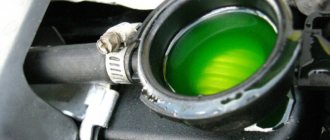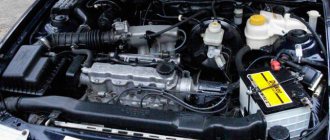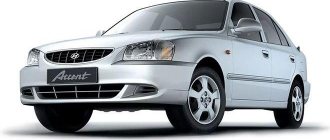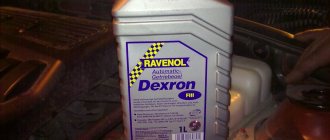What kind of fluid should I put in the power steering Dexron III ATF Multi HF? This question worries many beginners, as well as quite experienced drivers! The thing is that, as such, specialized fluids for power steering are very difficult to find on the automotive market, so according to advice from forums or friends, pour the following into the power steering fluid reservoir:
- Dexron (II - VI), the same as ATP liquid, only a different set of additives;
- PSF (I - IV);
- regular ATF, as in an automatic transmission;
- Multi HF.
As part of this article, I will give you a rating of the best power steering fluids 2022 - 2022 according to drivers, and you yourself will be able to choose the highest quality product for yourself at the best price.
Popularly, oils for the power steering system are distinguished by color. However, the real differences are not in color, but in the composition of the oils, their viscosity, the type of base, and additives. Oils of the same color can be completely different and not even mix. To say that if red oil is poured in, then another red oil can be added is completely wrong.
Table of colors and technical characteristics of power steering fluids
In order to better understand how power steering fluids differ from each other, I offer you this table:
| Power steering fluid color | Peculiarities |
| Red | Dexron family (mineral and synthetic red oils cannot be mixed!). Dexrons come in several types, but they all belong to the ATF class, i.e. class of oils for automatic transmissions (and sometimes power steering) |
| Yellow | The yellow family of power steering oils is most often used in Mercedes. |
| Green | Green oils for power steering (mineral and synthetic green oils cannot be mixed!) are loved by the VAG concern, as well as Peugeot, Citroen and some others. Not suitable for automatic transmissions. |
I would also like to note that special fluids are poured into the power steering: Therefore, when compiling our rating, this factor was also taken into account!
How to top up
The process of topping up is simple - you need to unscrew the cap of the power steering expansion tank and add enough fluid so that it is between the MIN and MAX marks.
The main problem when adding power steering oil is its choice. It’s good if the replacement has not yet been made, and the system contains fluid from the manufacturer’s factory. In this case, it is enough to check the technical documentation, take the recommended oil and add to the required amount.
If you don’t know what’s in the system, we recommend replacing it right away, because in any case you’ll have to buy a canister of fluid to top it up.
Share with friends on social networks:
Telegram
Rating of power steering fluids 2022 - 2022 in tables
ATF fluids for power steering
Automatic transmission oils (ATF) when filled into the power steering have the same functions as power steering fluids, the function of increasing the static friction of the clutches (depending on the material of the clutches) and the function of reducing clutch wear.
Rating of ATF fluids for power steering 2022 – 2019
| Rating of ATF fluids for power steering 2022 – 2019 | 1 | Formula Shell Multi-Vehicle ATF | from 360 rub. |
| 2 | Motul Multi ATF | from 800 rub. | |
| 3 | ZIC ATF III | from 400 rub. | |
| 4 | Mobil ATF 320 Premium | from 400 rub. | |
| 5 | Liqui Moly Top Tec ATF 1100 | from 350 rub. |
Mobil ATF 320 Premium fluid has a mineral composition. Place of application: automatic transmissions and power steering, which require Dexron III level oils. The product is designed for freezing temperatures of 30-35 degrees below zero. Mixes without consequences with red ATP fluids of the Dextron 3 classification. Compatible with all conventional seal materials used in transmission mechanisms.
The best power steering fluids (PSF)
If you intend to fill the power steering with PSF fluid, then you will need to consider the following: the fluid acts as a working fluid that transmits pressure from the pump to the piston, a lubricating function, an anti-corrosion function, and heat transfer to cool the system.
| Place | Name/Price | |
| 1 | RAVENOL Hydraulik PSF Fluid | from 1100 rub. |
| 2 | Pentosin CHF 11S | from 800 rub. |
| 3 | Motul Multi HF | from 600 rub. |
| 4 | Comma PSF MVCHF | from 500 rub. |
| 5 | LIQUI MOLY Zentralhydraulik-Oil | from 1000 RUR |
The best power steering fluids Dextron
The Dexron family was originally developed for use as hydraulic oils in automatic transmissions. Therefore, sometimes these oils are called transmission oils, which creates confusion, since transmission oils used to mean thick oils of the GL-5, GL-4, TAD-17, TAP-15 brands for gearboxes and rear axles with hypoid gears. Hydraulic oils are much thinner than transmission oils. It's better to call them ATPs. ATF stands for Automatic Transmission Fluid (literally - Fluid for automatic transmissions - i.e. automatic transmissions)
| 1 | Mannol Dexron III Automatic Plus | from 550 rub. |
| 2 | ENEOS Dexron ATF III | from 450 rub. |
| 3 | Castrol Transmax DEX-VI | from 220 rub. |
| 4 | Motul DEXRON III | from 600 rub. |
| 5 | Febi 32600 DEXRON VI | from. 400 rub. |
Semi-synthetic transmission fluid Motul DEXRON III is a product of technosynthesis. Red oil is intended for any systems that require fluid of DEXRON and MERCON standards, namely: automatic transmissions, power steering, hydrostatic transmission. Motul DEXRON III has easy fluidity in extreme cold and has a stable oil film even at high temperatures. This gear oil can be used where the use of DEXRON II D, DEXRON II E and DEXRON III fluids is recommended.
Different types of oils
Dexron is a separate class of ATF fluids from General Motors, produced since 1968. Dexron is a trademark, produced both by GM itself and by other companies under license.
ATF (Automatic Transmission Fluid) - oils for automatic transmissions, often used by Japanese automakers and in power steering.
PSF (Power Steering Fluid) - literally translated as power steering fluid.
Multi HF are special, universal power steering fluids that have approvals from most automobile manufacturers. For example, CHF liquid, produced by the German company Pentosin, has received approvals from BMW, Ford, Chrysler, GM, Porsche, Saab and Volvo, Dodge, Chrysler.
What is better for power steering: mineral oils or synthetics
The long-standing debate about which is better - synthetic or mineral water for the power steering system is not appropriate. The fact is that in the power steering there are a lot of rubber parts like nowhere else. Synthetic oils have a worse effect on the life of rubber parts based on natural rubber (almost all types of rubber), due to their chemical aggressiveness. In order to fill synthetic oils into the power steering system, its rubber parts must be designed for synthetic oils and have a special composition.
Power steering fluid (oil)
Rare cars use synthetic oils for power steering! But synthetic oils are often used in automatic transmissions. Fill the power steering system only with mineral water, unless the instructions specifically indicate synthetic oil!
Do-it-yourself oil change in the hydraulic booster
The first thing that comes to mind during such a procedure is the question - how much oil is in the power steering? There is no general value here, so this parameter needs to be clarified in the technical documentation for the car. On average, this is about 500-800 ml, so, most likely, one liter bottle of new replacement fluid, and another one for flushing lines and components, will be enough.
To replace it yourself, you will need the following tools:
- 20 gram syringe (so as not to rack your brains about how to drain the oil from the power steering);
- an empty 1.5 liter plastic bottle (in order to have somewhere to drain the old oil, for convenience it is better to cut off the neck and make an impromptu glass);
- screwdriver and wrenches (just in case, prepare open-end and socket wrenches);
- rags;
- funnel;
- a set of screw clamps (they will replace the standard ones).
There are two methods to change the oil.
Method 1: Partial replacement
This method is considered the simplest and most convenient, but it is also less effective.
First, you need to unscrew the cap of the power steering oil reservoir and pump out the liquid using a prepared syringe to the level of the filter. After this, you can fill in new oil until about 0, start the engine and turn the steering wheel to its extreme positions. Next, turn off the engine and repeat the procedure. You need to add liquid until you get the desired result.
Don't be alarmed if the liquid foams and bubbles after the first refill - this is normal. The main thing is that the oil “comes to its senses” after several procedures. The absence of bubbles also indicates that there is a sufficient amount of lubricant in the power steering.
Method 2: Complete replacement
This method takes a little more time and effort, but you can achieve excellent results and 100% fluid replacement.
To make it easier to work in front of the car, it is better to hang it up, then you can easily turn the steering wheel, even with the engine off. Next, you need to unscrew the cap of the power steering reservoir and completely pump out the old oil. After that, follow these steps:
- Raise the front wheels of the car so that they do not touch the ground.
- Use a syringe to remove old oil from the power steering reservoir, and then remove the filter element.
- Loosen the clamps on the hoses that go to the tank. Remove the hoses and tank, it is better to wash the latter.
- After cleaning, the tank must be put back in place and the hose going to the power steering pump must be connected to it.
- The second hose coming from the power steering must be directed into a plastic glass made from a bottle. Don’t forget to close the open tank fitting, for example, with a rubber hose of a suitable diameter covered with a bolt on the reverse side.
- Fill the reservoir with fresh oil to the maximum level. It is not necessary to install a filter element.
- Sit behind the wheel and start turning the steering wheel to its extreme positions. Thanks to these manipulations, the remaining old oil will be removed from the system.
- When removing used oil, you need to monitor the level of fresh oil in the tank. As soon as it drops to the minimum level, replenish it again. Thus, you will eliminate the possibility of airing the system.
- Add oil and turn the steering wheel until clear fluid comes out of the return line.
- Put on the hoses and put the filter element in place.
- Add oil to the maximum level and turn the steering wheel again.
- Without closing the reservoir cap, start the engine and turn the steering wheel again.
- Once air bubbles stop coming out of the return hose, turn off the engine. Lower the front wheels to the ground and add oil to the required level.
- Close the tank lid. Ready!
Table of differences between power steering oils PSF and ATF
| Power steering oils (PSF): | Automatic transmission oils (ATF): | |
| Functions of hydraulic fluid | 1) the liquid acts as a working fluid that transmits pressure from the pump to the piston 2) lubricating function 3) anti-corrosion function 4) heat transfer to cool the system | 1) the same functions as power steering fluids 2) the function of increasing the static friction of the clutches (depending on the material of the clutches) 3) the function of reducing clutch wear |
| Additives contained in the liquid | 1) friction reducing additives (metal-metal, metal-rubber, metal-fluoroplastic) 2) viscosity stabilizers 3) anti-corrosion additives 4) acidity stabilizers 5) coloring additives 6) anti-foam additives 7) additives protecting rubber parts (depending on the type of rubber mixtures) | 1) the same additives as power steering oils 2) additives against slippage and wear of automatic transmission clutches corresponding to the specific material of the clutches. Different clutch materials require different additives. This is where different types of automatic transmission fluids came from (ATF Dexron-II, ATF Dexron-III, ATF-Type T-IV, and others) |
Replacement frequency
Most car manufacturers recommend replacing this technical fluid after 80-100 thousand kilometers.
However, it is not always worth sticking to this rule. In machines that are operated in difficult climatic conditions and are subject to other serious loads, it is better to reduce the period between replacements.
Much depends on the weather conditions in the region and how the machine is used. It is important to monitor not so much the mileage on the odometer as the condition of the lubricant.
Please help with translation:
Mendeleev was foreshadowed in his great generalization by De Chancourtois's helix of elements of 1863, JAR New-lands's *law of octaves* (1864-5) - which uncovered periodicity in the 8th elements of his chemical groupings - and W. Odling's work, which suggested that recurrent chemical properties in elements arranged according to atomic weight could not be accidental.
English Russian
Measuring the positive side of the work–family interface: Development and validation of a work–family enrichment scale
English Russian
Giving a definition of the term “comedy”, one may face some difficulties as it's one of the most complex categories of aesthetics. Comedy is historically volatile, it depends on the context and has a social nature. The laughter is not always a sight of comedy, and comedy is not always defined by laughter. It is circumstances, sharpening the contradictions and helping to reveal its social nature
English Russian
It slides comfortably into the 'affordable' bracket though, considering its supersized display, and when it lands on contract (which should be soon) it won't carry hefty monthly fees.
English Russian











